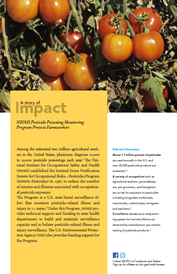NIOSH Pesticide Poisoning Monitoring Program Protects Farmworkers
December 2011
DHHS (NIOSH) Publication Number 2012-108

A Story of Impact:
Among the estimated two million agricultural workers in the United States, physicians diagnose 10,000 to 20,000 pesticide poisonings each year.1 The National Institute for Occupational Safety and Health (NIOSH) established the Sentinel Event Notification System for Occupational Risks – Pesticides Program (SENSOR-Pesticides) in 1987 to reduce the number of injuries and illnesses associated with occupational pesticide exposure.
The Program is a U.S. state-based surveillance effort that monitors pesticide-related illness and injury in 11 states.2 Under this Program, NIOSH provides technical support and funding to state health departments to build and maintain surveillance capacity and to bolster pesticide-related illness and injury surveillance. The U.S. Environmental Protection Agency (EPA) also provides funding support for the Program.
The SENSOR-supported surveillance systems tabulate the number of acute occupational pesticide poisonings, allowing for the timely identification of outbreaks. The Program also helps develop preventive interventions and maintains a national database that compiles information from participating states. Researchers and government officials from the SENSOR-Pesticides Program have published research articles highlighting findings from the data and build state and national capacity by facilitating communication across participating states. Publications have discussed issues as diverse as pesticide poisoning among agricultural workers, pesticide poisoning in schools, birth defects, and residential use of total release foggers (aka: bug bombs), which are devices that release an insecticide mist.3
Relevant Information
- About 1.1 billion pounds of pesticides are used annually in the U.S. and over 20,000 pesticide products are marketed.6,7
- A variety of occupations such as agricultural workers, groundskeepers, pet groomers, and fumigators are at risk for exposure to pesticides including fungicides, herbicides, insecticides, rodenticides, fumigants and sanitizers.2
- Surveillance serves as an early warning system for harmful effects not detected by manufacturer pre-market testing of pesticide products.2
Impact
View/Download Entire Document: NIOSH Pesticide Poisoning Monitoring Program Protects Farmworkers [PDF – 1.37 MB]
To receive NIOSH documents or more information about occupational safety and health topics, please contact NIOSH.
Telephone: 1-800-cdc-info (1-800-232-4636) | TTY: 1-888-232-6348 | email: cdcinfo@cdc.gov | www.cdc.gov/niosh
For a monthly update on news at NIOSH, subscribe to NIOSH eNews by visiting www.cdc.gov/niosh/eNews.
DHHS (NIOSH) Publication No. 2012-108
References
1 US EPA [1992]. Regulatory impact analysis of worker protection standard for agricultural pesticides. Washington, D.C.: U.S. Environmental Protection Agency.
2 Calvert GM, Plate DK, Das R, Rosales R, Shafey O, Thomsen C, Male D, Beckman J, Arvizu E, Lackovic M [2004]. Acute occupational pesticide-related illness in the US, 1998-1999: surveillance findings from the SENSOR-pesticides program. Am J Ind Med 45(1):14-23.
3 CDC (Centers for Disease Control and Prevention) [2008]. Illnesses and injuries related to total release foggers — eight states, 2001-2006. MMWR 57(41):1125-1129.
4 Calvert GM, Alarcon WA, Chelminski A, Crowley MS, Barrett R, Correa A, Higgins S, Leon HL, Correia J, Becker A, Allen RH, Evans E [2007]. Case report: Three farmworkers who gave birth to infants with birth defects closely grouped in time and place ─ Florida and North Carolina, 2004-2005. Environ Health Perspect 115(5):787-791.
5 Calvert GM, Higgins SA [2010]. Using surveillance data to promote occupational health and safety policies and practice at the state level: a case study. Am J Ind Med 53(2):188-193.
6 Grube A, Donaldson D, Kiely T, Wu L [2011]. Pesticides industry sales and usage. 2006 and 2007 market estimates. Washington, DC: U.S. Environmental Protection Agency, EPA Report No. EPA-733-R-11-001.
7 7. National Pesticide Information Retrieval System [2011]. Federal pesticide product [http://ppis.ceris.purdue.edu/htm/product.htm]. Date accessed: October 2011.
